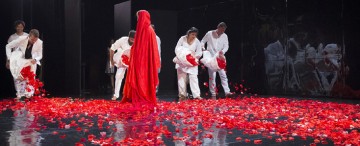
Orfeo, crossing the Gange
A show by Françoise Lasserre
Arsenal, Metz – 1st October 2016
by Laurent Bergnach
While this year is dedicated to celebrating Shakespeare’s (1564-1616) genius — particularly in Budapest with works like Otello, Sly and Lear [read our columns of 27, 29 and 31 mai May 2016] – and the madness of an anti-hero created by Cervantès (1547-1616), the figure of Orfeo has been equally present, with lyrical adaptations signed by Telemann, Monteverdi, Gluck or Rossi [read our columns of 9 July juillet, du 13 mai May, du 31 mars March and 4 février February 2016]. How could anyone who dedicates their life to the art of soothing the soul, remain indifferent to Calliope’s son, a poet and musician?
Designed by Françoise Lasserre, the founder of the thirty-year-old Akadêmia ensemble, Orfeo, Crossing the Ganges (2013) is based on the work by the man from Cremona (1567-1643), Orfeo (1607), performed by thirteen highly experienced artists on ancient instruments (viola de gamba, theorbes, cornettos, harpsichord, lirone, etc.). Not entirely, however, as several moments are missing (most obviously the opening fanfare and the Apollonian finale) replaced by music from the Republic of India. Looking down on the orchestra pit, stage right, seven virtuosos make their strings (sarangi, tampura), skins (tabla, pakhawaj), and reeds (shehnai) ring out, while Arushi Mudgal an Odissi dancer, dressed in red, with bells around her ankles, provides powerful and elegant interludes in a classical dance style from East India.
The conductor’s love for this land began just before she turned twenty. Her involvement there is growing as she understands the difficulties of the youngest artists who want to train in the Western repertory. This evening the choir of nymphs is made up of eight young girls from the Vocal Academy of India. In an attempt to underscore the similarities between the modalities, the relationship to ornamentation and the sense of improvisation, she brings the East and West together around an “imaginary tragedy” based on Striggio’s libretto. Orfeo falls in love with a temple dancer dedicated to Shiva, he carries her off and marries her. A distressed Eurydice fades away before our eyes, retiring and mute (Hadhoum Tunc).
François Rancillac’s sober stage direction (reflective backdrop, a rail along the ramp) sets off the primary colours of the costumes (Sabine Siegwalt). If before the interval the simplistic joy of baroque celebrations (unsullied garments, vermillion petals, candles) leaves us with a sense of déjà vu, the second half is far more interesting. Here India is no longer limited to the dancer lost in the labyrinths of Hell, it is also present in the inhabitants, turbaned and bare-chested in the manner of certain Shaivites. Adequately disturbing, the spirits disappear beneath long red veils, fitted with tiny invisible bells.
Dávid Szigetvári plays the leading role with body, depth and nuance [read our column of 13 August notre chronique 2014]. In addition to playing one of the shepherds alongside the faithful Johannes Weiss and Jan Van Elsacker [read our columns of 24 August 2011 and 31 August 2005 24 août 2011 et du 31 août 2005], Jean-Christophe Clair (Speranza) is a delight with his brave, rounded and agile voice as is Hugo Oliveira (Caronte) with his unwavering expressiveness. Jean-Claude Saragosse (Plutone) sings a steady bass in response to Harmonie Deschamps’ (Proserpina) youthful agility. Lastly, we should once more congratulate Dagmar Saskova (Musica, Messaggiera), a mezzo with unlimited qualities: breadth, ease, purity, as well as tenderness and expressivity in the Merula lullaby (1595-1665), that brings the two orchestras together in a magnificent ending to the evening. [read our columns of 6 October 2012 and 24 January 2010 6 octobre 2012 et du 24 janvier 2010].
LB